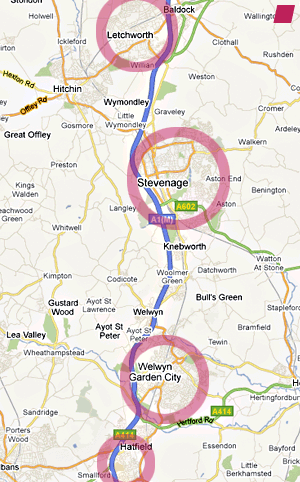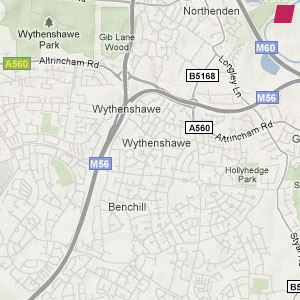| |
- IN 'Garden Cities and New Towns - Five Lectures' [1989] by David Hall, Robert Beevers, Michael Hebbert, Mervyn Miller, William Allen [and John Onslow], published by Hertfordshire Publications in 1990
http://books.google.at
'Ebenezer Howard: The Man and his Message' by Robert Beevers
Img. _ 01 [page 21, caption:] » 3. The Social City. The final version from Howard's To-morrow: A Peaceful Path to Real Reform, 1898 «
1 [page 27]
3 [page 28] Alfred Russel Wallace
4 » Nevertheless, he [Howard] persisted with the idea […] that is was the intention of the board of directors "at a later stage" "to create a Trust which would purchase the estate from the shareholders and administer the garden city under the democratic control of the inhabitants. […] thereafter the idea was quietly dropped. « [page 29]
- 'Britain's New Towns' by Anthony Alexander, published by Routledge 2009
2 Year of designation [ to commence the 'New Town' ]
- 'Garden Cities of To-morrow' by Ebenezer Howard, published by S. Sonnenschein & Co., Ltd. 'Second Edition' [1902], republished 2008 by Forgotten Books
[Includes many text errors - see instead:
http://www.archive.org/]
5 » For landlord's rent or interest on purchase money £ 2400,00 at 4 per cent « [page 33]
6 » K(Interest) The money to construct the public works with which we have been dealing is supposed to be borrowed at 4 1/2 per cent. « [page 54]
7 Return for investments was limited to 5% IV.) 9
» A limited dividend of 5 per cent is fixed; all profits beyond that are expended in useful public enterprises […] « [page 74]
- 'Urban Utopias in the Twentieth Century: Ebenezer Howard, Frank Lloyd Wright, and Le Corbusier' by Robert Fishman, published by Basic Books, New York in 1977
http://books.google.at/
9 a » "Philanthropy at 5 percent" was a familiar feature in English reform circles […] « [page 46]
[this notion seems proverbial: "Pure philanthropy is very well in its way but philanthropy plus five percent is a good deal better" Cecil Rhodes] see also: XI.) 12
- Google Maps - 2009
Img. _02 Letchworth, Stevenage, Welwyn Garden City, Hatfield
Img. _08 Wythenshawe, Manchester
- 13 a [Pre] financed cities [Model Villages] by philanthropists / entrepreneurs :
Robert Owen's New Lanark [1786]
Titus Salt's Saltaire [1853]
[… http://www.archive.org/]
and
by members of Howard's 'Garden City Association' at the time [by 1902]
George Cadbury's Bournville [1893]
William Lever's Port Sunlight [1887, 1899 - 1914]
Joseph Rowntree's New Earswick [1901 planned by Unwin & Parker]
- 8 The site of Letchworth Garden City was accquired as a freehold […] Common practise regarding English land ownership are leaseholds.
10 In a German context leasehold estates cannot be traded or borrowed on. "Pacht" [lease] here remains a mutual agreement.
In order to explain Howard's socio-economic prerequisites [in 1911] German architect Berlepsch-Valendas points out: "[In England] All land belongs to the sovereign [= state …]" [page 24 onwards]
- IN: ^ [Substituting "social" for "ecological", as its prerequisite …]
ECOLOGICAL URBANISM: Alternative and Sustainable Cities of the Future Conference at Harvard University Graduate School of Design April 3 - 5, 2009
http://ecologicalurbanism.gsd.harvard.edu/
11 More urban metaphors are noted by Lawrence Buell
- 'Die Gartenstadtbewegung in England, ihre Entwickelung und ihr jetziger Stand [The Garden City Movement in England, its development and current state]' by Hans Eduard Berlepsch-Valendas [architect B.D.A], published by R. Oldenbourg München und Berlin 1911 http://www.archive.org/
Img. _05 Letchworth Garden City by 1910 [page 132] http://www.archive.org/
Img. _06 Hampstead Garden Suburb [page 154] http://www.archive.org/
- 'Milton Keynes: image and reality' by Terence Bendixson and John Platt, published by Granta Editions, Cambridge 1992 [reprinted 1998] http://books.google.at/
Img. _07 [page 219] Plan of Welwyn, 1921
22 Caption for Img. _07 [page 219]
- ^ 'Cities of Tomorrow [An Intelectual History of Urban Planning and Design in the Twentieth Century]' by [Sir] Peter Geoffrey Hall, published by Wiley-Blackwell Publishing 2002 [third edition, published first 1988] http://books.google.at/
12 » These calculations appeared realistic: in low-inflation late Victorian England, consols might pay as little as 2 percent a year; 'philanthropy plus five percent' IV.) 9 was a well-known concept. « [page 97]
15 [page 102]
16 [page 101]
17 [page 104]
Other "Garden Suburbs":
Bedford Park [Ealing Garden Suburb 1875]
Brentham Garden Suburb [1901, planned by Unwin & Parker 1907]
18 [page 110]
19 [page 108]
20 [page 114]
- 'Town Planning in Practice: An introduction to the art of designing cities and suburbs' by [Sir] Raymond Unwin published by T. Fischer Unwin, London 1909 http://www.archive.org/ 2
21 [page 4]
Img. _03 [page 143, diagram of London] http://www.archive.org/
Img. _04 [page 232, plan of Earswick] http://www.archive.org/
- IN: ^
'Kunst des Städtebaus: neue Perspektiven auf Camillo Sitte' edited by Klaus Semsroth, Kari Jormakka and Bernhard Langer, published by Böhlau, 2005 http://books.google.at/
'Politische Konnotationen des malerischen Städtebaus [Political Connotations of the Picturesque]' by Wolfgang Sonne [page 63 to 89]
How do we [literally] perceive architecture, the city, the universe …?
Some recognize to be "in" the world, immersed in reality [immanently enjoying it] others aspire to detach from misery, transcending to higher levels, [preferably] looking down on matters […].
What renders the "picturesque" an issue in architectural discourse are "renderings".
- IN:
'Town Theory and Practice' edited by Charles Benjamin Purdom, published by Benn Brothers London, 1921 http://www.archive.org/
'An Introductory Chapter' by C. B. Purdom [pages 9 to 46]
23 Their 1919 definition: » A Garden City is a town planned for industry
and healthy living ; of a size that makes possible
a full measure of social life, but not larger ; surrounded by a permanent belt of rural land ; the whole
of the land being in public ownership or held in trust
for the community. «
[page 34] http://www.archive.org/
- ^ 'Satellite Cities : A Study of Industrial Suburbs' by Graham Romeyn Taylor, published by D. Appleton and Company, New York, London 1915 http://www.archive.org/
|






!['GROUP OF SLUMLESS SMOKELESS CITIES' 1898 by Ebenezer Howard, from 'Garden Cities and New Towns - Five Lectures' [1989] by David Hall, Robert Beevers, Michael Hebbert, Mervyn Miller, William Allen [and John Onslow], published by Hertfordshire Publications 1990 'GROUP OF SLUMLESS SMOKELESS CITIES' 1898 by Ebenezer Howard, from 'Garden Cities and New Towns - Five Lectures' [1989] by David Hall, Robert Beevers, Michael Hebbert, Mervyn Miller, William Allen [and John Onslow], published by Hertfordshire Publications 1990](content/ebenezer_howard_social_city_1898.jpg)

!['Diagrammatic Plan of London' by [Sir] Raymond Unwin from 'Town planning in practice: An introduction to the art of designing cities and suburbs' published by T. Fischer Unwin, London 1909 'Diagrammatic Plan of London' by [Sir] Raymond Unwin from 'Town planning in practice: An introduction to the art of designing cities and suburbs' published by T. Fischer Unwin, London 1909](content/unwin_london_1909.jpg)
!['Plan of Earswick' by [Sir] Raymond Unwin from 'Town planning in practice: An introduction to the art of designing cities and suburbs' published by T. Fischer Unwin, London 1909 'Plan of Earswick' by [Sir] Raymond Unwin from 'Town planning in practice: An introduction to the art of designing cities and suburbs' published by T. Fischer Unwin, London 1909](content/new_earswick_orig_1902.jpg)
!['Letchworth Garden City by 1910' planned by Richard Barry Parker and [Sir] Raymond Unwin 1904 image taken from 'Die Gartenstadtbewegung in England, ihre Entwickelung und ihr jetziger Stand' by Hans Eduard Berlepsch-Valendas [architect B.D.A], published by R. Oldenbourg München und Berlin 1911 [page 132] 'Letchworth Garden City by 1910' planned by Richard Barry Parker and [Sir] Raymond Unwin 1904 image taken from 'Die Gartenstadtbewegung in England, ihre Entwickelung und ihr jetziger Stand' by Hans Eduard Berlepsch-Valendas [architect B.D.A], published by R. Oldenbourg München und Berlin 1911 [page 132]](content/letchworth_garden_city_1903.jpg)
!['Hampstead Garden Suburb' planned by Richard Barry Parker and [Sir] Raymond Unwin 1906 image taken from 'Die Gartenstadtbewegung in England, ihre Entwickelung und ihr jetziger Stand' by Hans Eduard Berlepsch-Valendas [architect B.D.A], published by R. Oldenbourg München und Berlin 1911 [page 154] 'Hampstead Garden Suburb' planned by Richard Barry Parker and [Sir] Raymond Unwin 1906 image taken from 'Die Gartenstadtbewegung in England, ihre Entwickelung und ihr jetziger Stand' by Hans Eduard Berlepsch-Valendas [architect B.D.A], published by R. Oldenbourg München und Berlin 1911 [page 154]](content/hampstead_garden_suburb_1906.jpg)
![Plan of 'Welwyn Garden City' 1921 by Louis de Soissons, image taken from 'Milton Keynes: image and reality' by Terence Bendixson and John Platt, published by Granta Editions, Cambridge 1992 [reprinted 1998, page 219] Plan of 'Welwyn Garden City' 1921 by Louis de Soissons, image taken from 'Milton Keynes: image and reality' by Terence Bendixson and John Platt, published by Granta Editions, Cambridge 1992 [reprinted 1998, page 219]](content/welwyn_garden_city_1921.jpg)

TOP
Social Networks